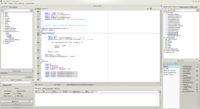Difference between revisions of "Coedit"
(→Development aspects) |
m (→Development aspects) |
||
| Line 8: | Line 8: | ||
The software is being developed since June 2014 but the idea is older [https://forum.dlang.org/post/upxejxdrlqinhtjicigb@forum.dlang.org as shown by a NG discussion] in February 2013. | The software is being developed since June 2014 but the idea is older [https://forum.dlang.org/post/upxejxdrlqinhtjicigb@forum.dlang.org as shown by a NG discussion] in February 2013. | ||
| − | The development started on Windows and the linux version was barely tested. Since September 2015 this is the opposite, linux is the main development platform. | + | The development started on Windows and the linux version was barely tested. Since September 2015 this is the opposite, linux is the main development platform. While in the past Coedit was more used under Windows since the third version the download statistics show that [http://www.somsubhra.com/github-release-stats/?username=BBasile&repository=Coedit linux it's more used under linux]. |
Coedit has the particularity of being written in [https://www.openhub.net/p/Coedit/analyses/latest/languages_summary Object Pascal]. It takes advantage of the [http://www.lazarus-ide.org/ Lazarus] development platform, its visual component library, the RAD concept and the [http://wiki.freepascal.org/SynEdit Synedit] code editor component. Some of the tools used in background are written in D. The [https://github.com/BBasile/Coedit/tree/master/cesetup setup program] is also a D program that's compiled directly in Coedit. | Coedit has the particularity of being written in [https://www.openhub.net/p/Coedit/analyses/latest/languages_summary Object Pascal]. It takes advantage of the [http://www.lazarus-ide.org/ Lazarus] development platform, its visual component library, the RAD concept and the [http://wiki.freepascal.org/SynEdit Synedit] code editor component. Some of the tools used in background are written in D. The [https://github.com/BBasile/Coedit/tree/master/cesetup setup program] is also a D program that's compiled directly in Coedit. | ||
Revision as of 13:55, 31 March 2017
Coedit is a free, open source, multi-plateform IDE dedicated to the D programming language, its compilers, libraries and tools.
Its name is the contraction of compile and edit.
Development aspects
The software is being developed since June 2014 but the idea is older as shown by a NG discussion in February 2013. The development started on Windows and the linux version was barely tested. Since September 2015 this is the opposite, linux is the main development platform. While in the past Coedit was more used under Windows since the third version the download statistics show that linux it's more used under linux.
Coedit has the particularity of being written in Object Pascal. It takes advantage of the Lazarus development platform, its visual component library, the RAD concept and the Synedit code editor component. Some of the tools used in background are written in D. The setup program is also a D program that's compiled directly in Coedit.
Each major version is named gold and comes with new features. They are followed by several regular updates with mostly bug fixes and improvements but also minor new features. The first major version was released on June 2015 and the second on February 2016. A third version was released on March 2017.
Features and tooling
Since the beginning, Coedit implements a system of runnable module. It allows to edit, compile and run a D module without typing a command line and without saving a file. A library manager allows any runnable module to use static libraries, still without specifying any compiler parameter.
The feature set is similar to any other IDE. Most of the IDE-grade features (completion, hints, code navigation) are provided by DCD. Other background tools used includes DUB, Dscanner, dfmt, cetodo, cesyms. In the third version, The background tools written especially for Coedit (cesyms and cetodo) are unified in a single tool called Dastworx (D AST works).
All the D compilers are supported. This is natural for the DUB projects since the build tool allows to select a particular compiler. Coedit also implements its own project format. It is based on the DMD command line interface so LDC and GDC are supported through the LDMD2 and the GDMD bridges.
Debugging is supported since version 3, using GDB, but only for the POSIX platform, because under Windows DMD still produces OMF objects and debugging information that GDB doesn't recognize.
Anecdotes
In a HackerNews comment, the author has described Coedit as a GUI with a lot of piped sub-processes under the hood.
